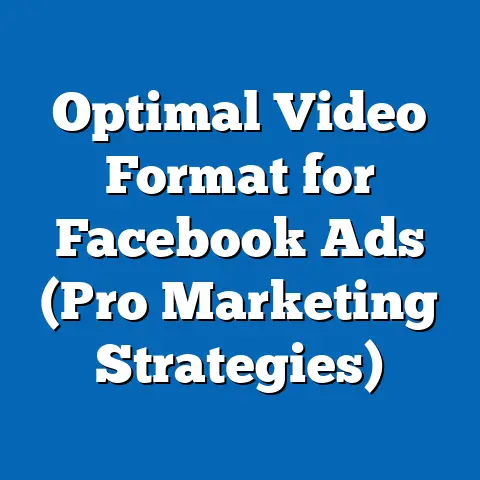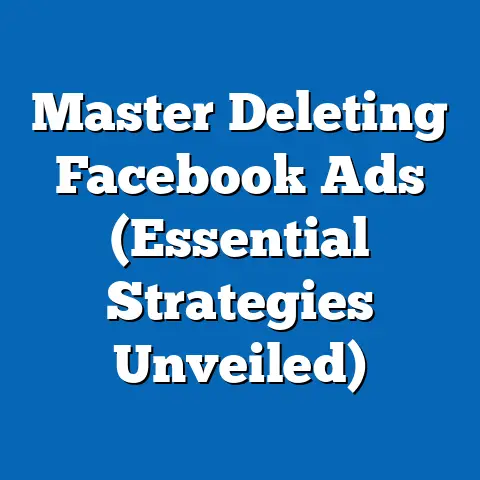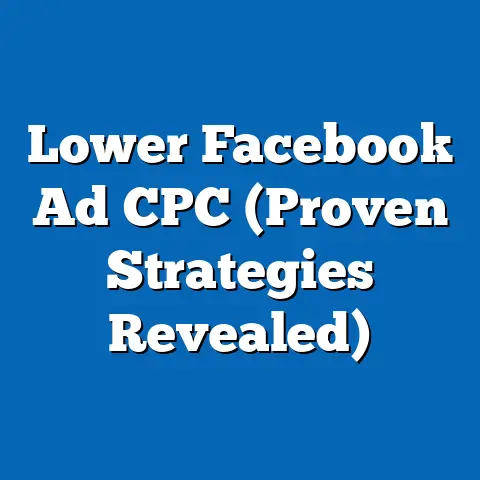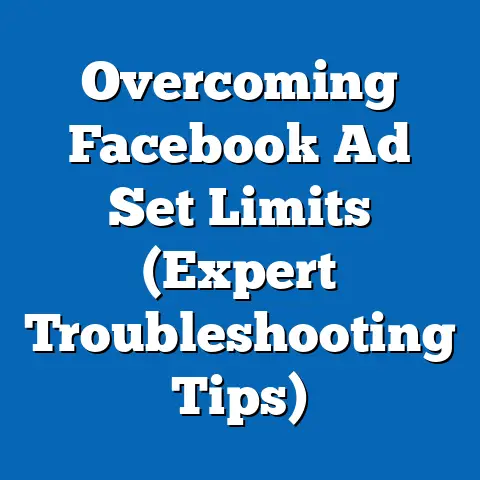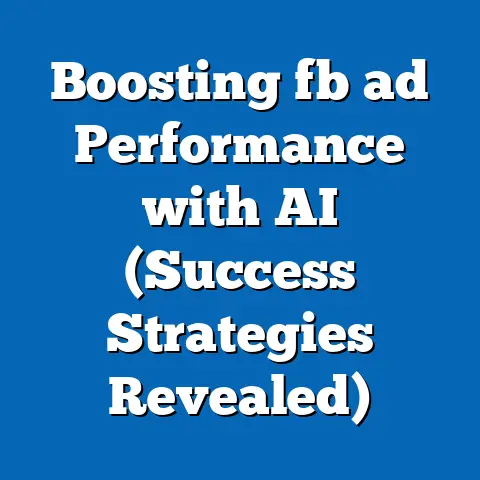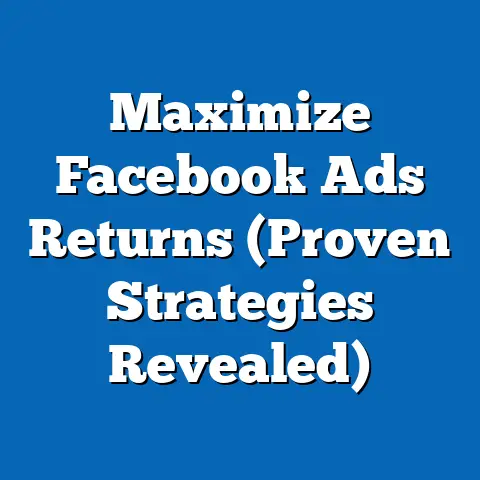Boost fb ad Impact with Optimal Frequency (Expert Insights)
Think of Gary Vaynerchuk. He’s everywhere, right? But somehow, his relentless presence across social media platforms doesn’t feel intrusive. It feels… valuable. That’s the magic of understanding frequency, especially when it comes to Facebook ads. He’s mastered the art of capturing attention without causing ad fatigue. He is a trendsetter in the digital marketing space. He has effectively used ad frequency to capture audience attention without causing ad fatigue. He’s positioned himself as a leader in the competitive landscape of social media marketing. Just like Gary Vee, mastering ad frequency is the secret weapon you need to truly amplify your Facebook advertising efforts. It’s not just about having a great ad; it’s about showing it to the right people, the right number of times. In this guide, I’m going to break down the art and science of ad frequency, sharing expert insights and actionable strategies to help you boost your Facebook ad impact.
Understanding Ad Frequency
Ad frequency, in the context of Facebook advertising, refers to the average number of times a single person sees your ad within a specific timeframe. It’s the measure of how often your message is being delivered to your target audience. I like to think of it as the number of taps on a potential customer’s shoulder – too few, and they might not notice you; too many, and you become annoying.
How Frequency is Measured and Why it Matters
Facebook provides a frequency metric within its Ads Manager. This number represents the average number of times each person in your target audience has seen your ad. It’s calculated by dividing the total impressions by the reach.
Formula: Frequency = Impressions / Reach
Why does this matter? Because frequency directly impacts your ad performance. A low frequency might mean you’re not reaching your audience effectively, while a high frequency can lead to ad fatigue, decreased engagement, and even negative brand perception.
Reach vs. Frequency: Finding the Sweet Spot
Reach and frequency are two sides of the same coin. Reach refers to the total number of unique individuals who saw your ad, while frequency refers to how many times each person saw the ad. The ideal scenario is to achieve a balance between the two.
Think of it like this:
- High Reach, Low Frequency: You’re reaching a lot of people, but they’re only seeing your ad once or twice. This can be good for brand awareness, but it might not be enough to drive conversions.
- Low Reach, High Frequency: You’re showing your ad to a small group of people multiple times. This can be effective for retargeting, but it can also lead to ad fatigue if not managed carefully.
- High Reach, Optimal Frequency: You’re reaching a large audience and showing them your ad just enough times to make an impact without causing annoyance. This is the sweet spot for most campaigns.
Statistics show that ad fatigue typically starts to kick in when frequency exceeds 3-4 within a week for most audiences. However, this number can vary depending on your industry, target audience, and the type of ad you’re running.
Takeaway: Understanding and monitoring your ad frequency is critical for optimizing your Facebook ad campaigns. Strive for a balance between reach and frequency to maximize your impact.
The Psychology Behind Ad Frequency
Advertising isn’t just about showing ads; it’s about understanding how people process information and make decisions. The psychology behind ad frequency plays a crucial role in determining the effectiveness of your campaigns.
The Mere Exposure Effect: Familiarity Breeds Preference
The Mere Exposure Effect, a concept in psychology, suggests that people tend to develop a preference for things merely because they are familiar with them. In other words, the more someone is exposed to something, the more they tend to like it.
In the context of Facebook advertising, this means that repeated exposure to your ad can increase brand recognition and create a sense of familiarity, leading to a more positive perception of your brand.
Behavioral Psychology and Brand Recognition
Behavioral psychology experts emphasize that repetition is key to memory and recall. When people see your ad multiple times, it increases the likelihood that they’ll remember your brand when they’re ready to make a purchase.
However, there’s a fine line between helpful repetition and annoying overexposure. The key is to strike a balance and ensure that your ads are relevant, engaging, and non-intrusive.
Here’s a personal example: I was once working with a local bakery that wanted to increase its brand awareness. We ran a Facebook ad campaign targeting people within a 5-mile radius. Initially, we kept the frequency low (around 1-2 per week). However, after analyzing the data, we noticed that engagement was low. We decided to increase the frequency to 3-4 per week, and the results were significant. We saw a noticeable increase in website traffic, in-store visits, and overall brand awareness. The key was that our ads were visually appealing and offered valuable information (e.g., daily specials, new products).
Takeaway: Leverage the Mere Exposure Effect by strategically increasing ad frequency to enhance brand recognition and recall. However, always be mindful of the potential for ad fatigue and adjust your strategy accordingly.
Identifying the Optimal Frequency
So, what exactly is the “optimal” frequency? Unfortunately, there’s no one-size-fits-all answer. It depends on a variety of factors, including your campaign goals, target audience, industry, and ad creative.
Expert Opinions on Optimal Frequency
Experts generally agree that the optimal frequency for most Facebook ad campaigns falls within the range of 2-5 times per week. However, this is just a guideline. Some campaigns may benefit from a higher frequency, while others may require a lower one.
Here’s a breakdown based on campaign type:
- Brand Awareness Campaigns: A lower frequency (2-3 times per week) might be sufficient to create initial brand recognition.
- Lead Generation Campaigns: A slightly higher frequency (3-4 times per week) can help encourage potential customers to take action.
- Retargeting Campaigns: A higher frequency (4-5 times per week) may be necessary to remind people of your product or service and encourage them to complete a purchase.
Case Studies and Data from Industry Leaders
Many case studies highlight the importance of finding the right frequency. For example, a study by Nielsen found that increasing ad frequency from 1 to 3 times per week resulted in a 20% increase in brand recall. However, increasing it further to 5 times per week only resulted in an additional 5% increase. This demonstrates the concept of diminishing returns.
Another case study by HubSpot found that retargeting ads with a frequency of 4-5 times per week had a 3x higher click-through rate than ads with a lower frequency.
The Role of Audience Segmentation
Audience segmentation plays a crucial role in determining the optimal frequency. Different customer personas may respond differently to ad frequency. For example, a loyal customer who already knows your brand may not need to see your ad as often as someone who is unfamiliar with your brand.
Consider segmenting your audience based on factors such as:
- Demographics: Age, gender, location, etc.
- Interests: Hobbies, activities, etc.
- Behaviors: Website visits, past purchases, etc.
- Customer Lifetime Value (CLTV): High-value customers vs. low-value customers
Takeaway: The optimal frequency varies depending on your campaign goals, target audience, and industry. Use data and testing to find the sweet spot for each segment of your audience.
The Risks of Overexposure
While strategic repetition can be beneficial, overexposure can be detrimental to your Facebook ad campaigns. Ad fatigue, negative brand perception, and diminishing returns are just some of the risks associated with high ad frequency.
Ad Fatigue and Negative Brand Perception
Ad fatigue occurs when people become tired of seeing the same ad repeatedly. This can lead to decreased engagement, negative reactions, and even brand avoidance.
Imagine seeing the same annoying ad every time you scroll through your Facebook feed. Eventually, you’ll start to associate that brand with negativity. This is the opposite of what you want to achieve with your advertising.
Diminishing Returns and Wasted Ad Spend
Overexposure can also lead to diminishing returns. After a certain point, each additional impression will have less and less impact. You’ll be spending money without seeing a corresponding increase in results.
Data shows that after a frequency of 5 or 6, engagement rates typically start to decline significantly. This means that you’re essentially wasting your ad spend on people who are already tired of seeing your ad.
Monitoring Metrics to Avoid Overexposure
The key to avoiding overexposure is to monitor your metrics closely. Pay attention to:
- Frequency: Keep track of the average number of times each person is seeing your ad.
- Reach: Monitor the total number of unique individuals you’re reaching.
- Engagement: Track metrics such as click-through rates, likes, comments, and shares.
- Negative Feedback: Watch out for negative comments, reports, and unlikes.
Takeaway: Overexposure can lead to ad fatigue, negative brand perception, and diminishing returns. Monitor your metrics closely and adjust your frequency accordingly to avoid these pitfalls.
Strategies to Optimize Ad Frequency
Now that you understand the importance of optimal frequency, let’s dive into some strategies you can use to manage it effectively within the Facebook ad platform.
Managing Frequency within Facebook Ads Manager
Facebook Ads Manager provides several tools and settings you can use to control ad frequency:
- Reach and Frequency Campaigns: This campaign objective allows you to specify the reach and frequency you want to achieve. It’s ideal for brand awareness campaigns where you want to reach a specific number of people a certain number of times.
- Frequency Capping: You can set a frequency cap to limit the number of times each person sees your ad within a specific timeframe. This helps prevent overexposure and ad fatigue. You can access this setting within the “Optimization & Delivery” section of your ad set.
- Audience Exclusion: Exclude people who have already seen your ad multiple times to avoid showing it to them repeatedly. This is particularly useful for retargeting campaigns.
A/B Testing for Optimal Frequency
A/B testing is a powerful tool for finding the sweet spot for frequency. Run two identical ad campaigns with different frequency caps and compare the results. The campaign with the higher engagement and conversion rates is likely the one with the optimal frequency.
For example, you could run one campaign with a frequency cap of 3 per week and another with a frequency cap of 5 per week. After a week or two, analyze the data and see which campaign performed better.
Advanced Techniques: Dynamic Ads, Retargeting, and Lookalike Audiences
- Dynamic Ads: Dynamic ads automatically show the most relevant products or services to each individual based on their browsing history and interests. This can help keep your ads fresh and engaging, even with a higher frequency.
- Audience Retargeting: Retargeting allows you to show ads to people who have already interacted with your website or app. This is a highly effective way to drive conversions, but it’s important to manage frequency carefully to avoid annoying your audience.
- Lookalike Audiences: Lookalike audiences allow you to target people who are similar to your existing customers. This can help you expand your reach and find new potential customers who are more likely to be interested in your products or services.
Takeaway: Use Facebook Ads Manager tools, A/B testing, and advanced techniques like dynamic ads, retargeting, and lookalike audiences to optimize your ad frequency and prevent overexposure.
Measuring the Impact of Frequency on Campaign Success
Ultimately, the success of your Facebook ad campaigns depends on your ability to measure the impact of frequency on your key performance indicators (KPIs).
Key Performance Indicators (KPIs) to Track
Here are some of the most important KPIs to track when evaluating the impact of frequency:
- Click-Through Rate (CTR): The percentage of people who click on your ad after seeing it. A declining CTR can indicate ad fatigue.
- Conversion Rate: The percentage of people who take a desired action (e.g., make a purchase, fill out a form) after clicking on your ad.
- Cost Per Acquisition (CPA): The cost of acquiring a new customer. A rising CPA can indicate that your ads are becoming less effective.
- Return on Ad Spend (ROAS): The amount of revenue you generate for every dollar you spend on advertising.
- Frequency: The average number of times each person sees your ad.
- Reach: The total number of unique individuals you’re reaching.
- Engagement: Metrics such as likes, comments, shares, and video views.
Analyzing Campaign Data to Assess Frequency Impact
Analyze your campaign data to identify the relationship between frequency and outcomes. Look for patterns and trends that can help you optimize your frequency strategy.
For example, you might notice that your CTR starts to decline significantly after a frequency of 4. This would indicate that you need to lower your frequency cap to avoid ad fatigue.
Insights from Analytics Experts
Analytics experts recommend using tools like Facebook Analytics and Google Analytics to track the performance of your Facebook ad campaigns. These tools can provide valuable insights into user behavior and help you understand how frequency is impacting your results.
Takeaway: Track your KPIs, analyze your campaign data, and use analytics tools to measure the impact of frequency on your ad effectiveness.
Conclusion
Crafting impactful Facebook ads is essential, but understanding and managing ad frequency is equally crucial for maximizing your ad performance and achieving your marketing goals. By understanding the psychology behind ad frequency, identifying the optimal frequency for your campaigns, avoiding the risks of overexposure, and using the right strategies and tools, you can boost your Facebook ad impact and drive better results.
Don’t be afraid to experiment with your frequency strategies based on the insights I’ve shared in this article. Remember, the optimal frequency is not a fixed number. It’s a moving target that requires constant monitoring and adjustment.
So, go ahead and start testing. See what works best for your audience and your campaigns. The results might surprise you. And who knows, you might just become the next Gary Vee of Facebook advertising!

